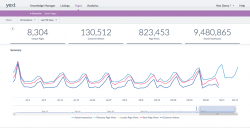Platform Updates
Yext Analytics for Pages
Your brand’s digital presence begins with your website. It’s the primary place that the public facts about your brand have to live. That means anything your customer could want to know about you — your location, your hours, your products, your services, your reviews — has to be easily available (and up to date!) on […]

Yext
Mar 16, 2017

Your brand's digital presence begins with your website. It's the primary place that the public facts about your brand have to live. That means anything your customer could want to know about you — your location, your hours, your products, your services, your reviews — has to be easily available (and up to date!) on your website. In addition to helping your site visitors find what they need, providing all this information on your website also ensures search engines can ingest that data — and display it in their own intelligent results. Either way, consumers get the data they want.
Earlier this week, we did a deep dive into Yext Analytics for Listings. We showed how Analytics gives you insight into everywhere your listings appear on local search sites, maps, and apps, including Google Maps, Facebook, and sites across the PowerListings® Network. In this post, we'll be looking at Analytics for Pages, which shows you those same insights (and more) for your local pages on your own website.
See the status of all your pages, at once.
As with Listings, Analytics for Pages starts by showing you the status of your pages before drilling down into how users are engaging with them.
These status metrics offer an immediate sense of the your pages' health, and the scale of the actions that you're driving through Yext. How many unique pages are you powering? How many views do those pages get? How many total actions, like clicks or calls, do consumers are make on those pages? You can filter all these metrics by location, time, or site, so you can drill down and see how individual locations are performing, or how you did in a certain month.
The colored line graph below displays these same metrics over an adjustable time scale. This provides a visual means to spot trends or spikes in activity for closer examination. Is there seasonality in your business that's reflected in the the search traffic to your pages? If so, are you doing everything to convert that traffic into visits during your most important times of the year?

Discover how your customers are engaging with you.
Yext Analytics for Pages gives you a single view of how and when consumers interact with your local Pages. The real meat of Analytics is these engagement insights. They tell you who's visiting your pages, what they're doing on the page, when they visited, and where they came from.
You can break down all that data by device, and day of the week, to uncover patterns and opportunities for improvement. You can also see your top referral traffic sources, as well as the days and times when you get the most traffic to your pages. You'll also be able to track the top terms for which your pages rank — in both branded and unbranded searches — and engagement rates for each of those terms.
For power users, Yext's integration with the Google Search Console allows you to tag your Pages any way you'd like, so you can view entirely custom reporting. Save reports to your Insights Library to view this data in your Dashboard.

Knowledge is power.
At Yext, we love data. And whether you're a CEO or an SEO, Analytics for Pages was built to make your data rich, easy to understand, and actionable. The possibilities of what you can do with this data are unlimited, and it's what you do with that information that will ultimately determine the success of your program.
Here are a few tips to get you started using Pages Analytics:
- Optimize your page layout for the devices that drive the highest engagement. If you get 90% of your traffic from mobile, make sure that the content you want to get in front of customers is optimized for mobile, so they can see what you want without having to scroll.
- Choose the best day and time to add fresh content based, on when consumers visit your Pages most frequently. If you're thinking of dropping a new promotion, you can determine when the best moment might be based on traffic trends.
- Infuse your digital marketing efforts with the search terms that drive the most engagement. Do a lot of customers find you through unbranded searches for something you may consider secondary? Make sure those terms are all over your next campaign.
The features listed above are now available in beta for users who subscribe to Yext Pages. For more information about Yext Analytics and the other features in the Spring 2017 product release, request a demo orsign up for our webinaron March 23rd. Yext Partner? Sign up for the webinarhere.